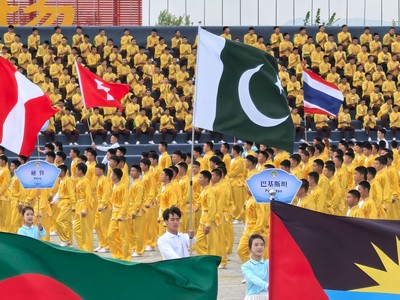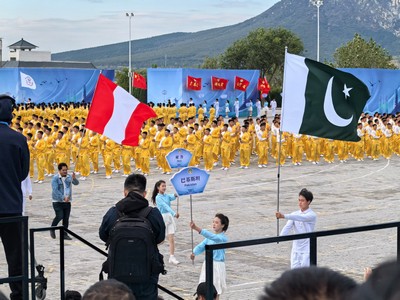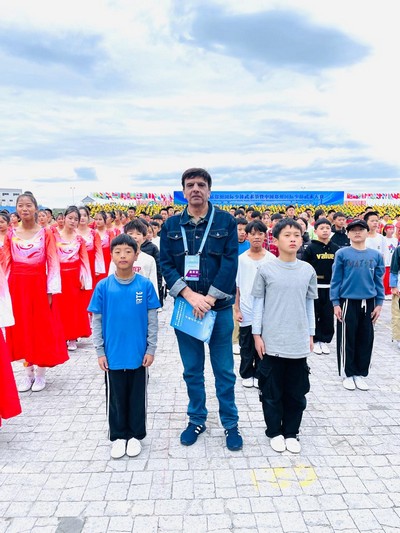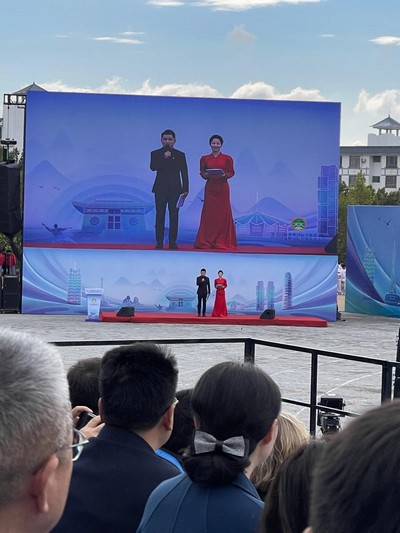Zhengzhou hosts spectacular martial arts event

The Zhengzhou Olympic Sports Center, with its symbolic representation of “the center of heaven and earth, the Yellow River’s waters,” played host to a spectacular martial arts event on October 20.
This unique event marked a major celebration of Chinese martial arts, serving as a key feature of the 13th Zhengzhou International Shaolin Martial Arts Festival.
The festival attracted 2,560 martial artists from 56 countries and regions, who came together to compete in the prestigious Shaolin Kung Fu contest and participate in the Chinese Martial Arts Duanwei (ranking) evaluations for overseas practitioners. The festivities showcased not only Shaolin Kung Fu but also a variety of other traditional martial arts forms, creating a rich tapestry of cultural and athletic exchanges.

Chinese martial arts, known for their deep cultural roots, have played a significant role in China’s heritage for centuries. Among them, Shaolin Kung Fu stands as one of the most celebrated styles, with a history spanning over 1,500 years. Often hailed as the origin of all martial arts, Shaolin’s influence extends far beyond China’s borders, and the festival aims to continue promoting its legacy on the global stage.
Zhao Hengkang, Deputy Secretary-General of the Zhengzhou Municipal Government, emphasized the importance of the event in preserving and promoting Shaolin martial arts culture. “Since its inception in 1991, the Zhengzhou International Shaolin Martial Arts Festival has attracted over 40,000 participants from more than 100 countries and regions,” Zhao stated. “The ongoing festival serves as a bridge for cultural exchange, allowing the world to experience the depth of Chinese martial arts while also enhancing Zhengzhou’s identity as ‘Kung Fu City.’”

The event featured a wide range of martial arts demonstrations, from Shaolin boxing’s powerful strikes to the fluid, balanced movements of Tai Chi, and the dynamic techniques of Xing Yi. Athletes took to the stage with mastery in traditional weaponry such as staffs, swords, and spears, presenting techniques perfected over years of disciplined training.
Among the festival’s many participants was Eleonora, a 60-year-old martial arts enthusiast from the Netherlands. Her passion for Kung Fu began in South America and eventually led her to China, where she pursued training under skilled masters. “I love the philosophy and wisdom embedded in martial arts. Zen martial arts, meditation, and traditional Chinese medicine have rejuvenated me,” she said. This year, she brought along her Bulgarian student, Tres, to compete in Shaolin Liuhe Quan, symbolizing how Kung Fu transcends borders and unites people across cultures.
The festival embraced participants of all ages, from as young as four to as old as 82, underscoring the universal appeal of martial arts. Six-year-old Xiao Jinyang, a Shaolin student who has been practicing for just a year and a half, stole the spotlight with his fluid movements, earning first place in the children’s boxing category. “I love practicing Kung Fu, singing, and reciting poems,” he said proudly. “I’ll keep training hard to win another gold medal next time.”
The Duanwei evaluations, which assess practitioners’ skills and moral character, drew participants from countries including Japan, Malaysia, and the Netherlands. The event featured various martial arts forms, such as Yang-style and Chen-style Tai Chi, Shaolin sword, Shaolin plum blossom broadsword, and the 42-form Tai Chi sword routine. Each competitor demonstrated their deep appreciation and dedication to martial arts with every punch, strike, and weapon flourish.

Wu Bin, Vice Chairman of the Chinese Wushu Association, spoke about the broader impact of the event. “Chinese martial arts have many different styles, all of which contribute to the richness of martial arts culture,” Wu said. “Hosting an international festival like this encourages practitioners from various disciplines to showcase their skills, helping preserve the diversity of Chinese martial arts and pass it on to future generations.”
The Duanwei evaluation focused on self-improvement and growth, emphasizing both technical skills and martial ethics. According to Chen Shun’an, an expert from the Wushu Research Institute of the General Administration of Sport of China, the standardized and systematic approach to the Duanwei ranking system is expanding internationally, providing a gateway for more foreigners to experience Chinese martial arts and understand the profound nature of Chinese culture.
The festival was not merely a competition but a celebration of martial arts’ ability to bring together diverse individuals from different backgrounds, skin colors, and cultures. Competitors and spectators alike gathered in Zhengzhou, the “center of heaven and earth,” to witness and participate in a remarkable display of skill and tradition, writing a new chapter in the ongoing legend of martial arts.
As the event concluded, it was clear that the spirit of Kung Fu remains vibrant and evolving, a testament to the enduring appeal of martial arts as both a physical and spiritual discipline. Zhengzhou, with its long history and deep cultural ties to Shaolin, continues to solidify its reputation as a global hub for martial arts.





